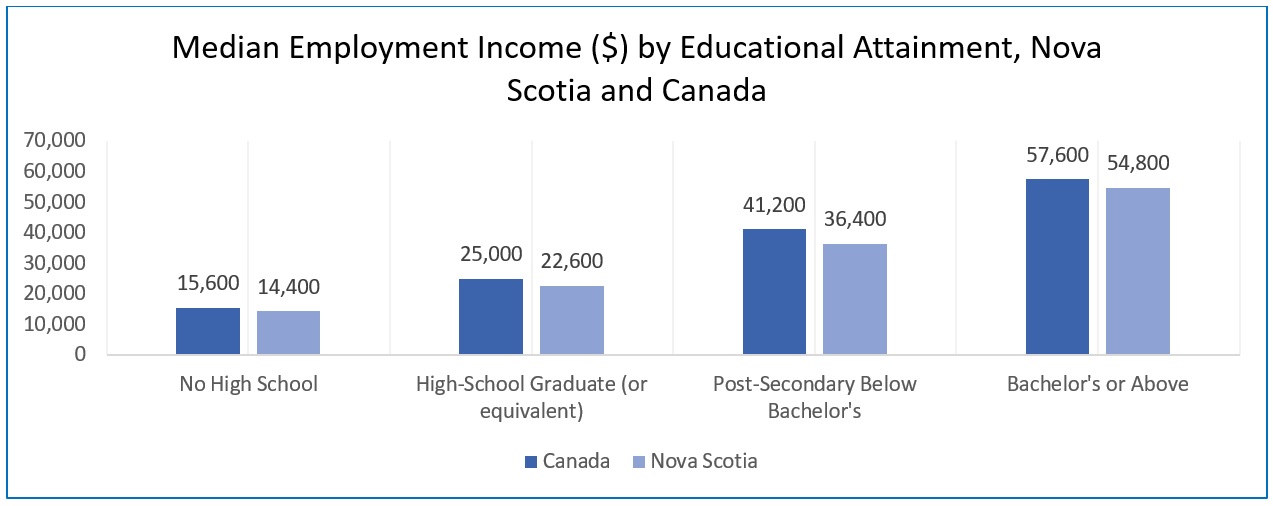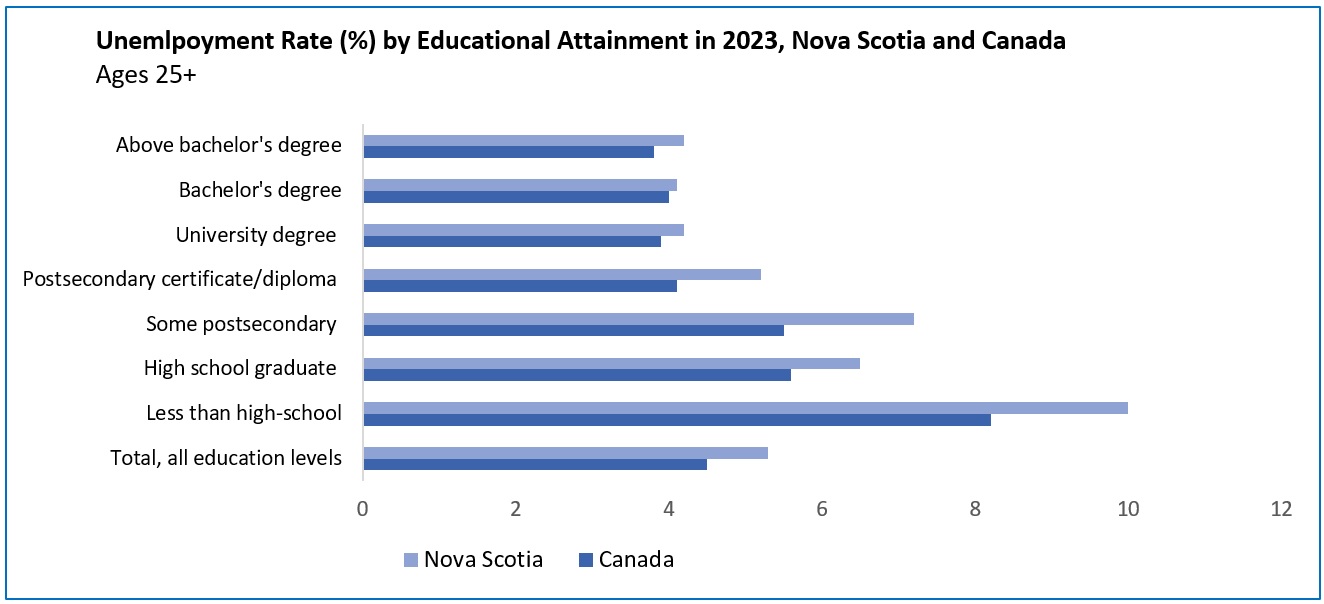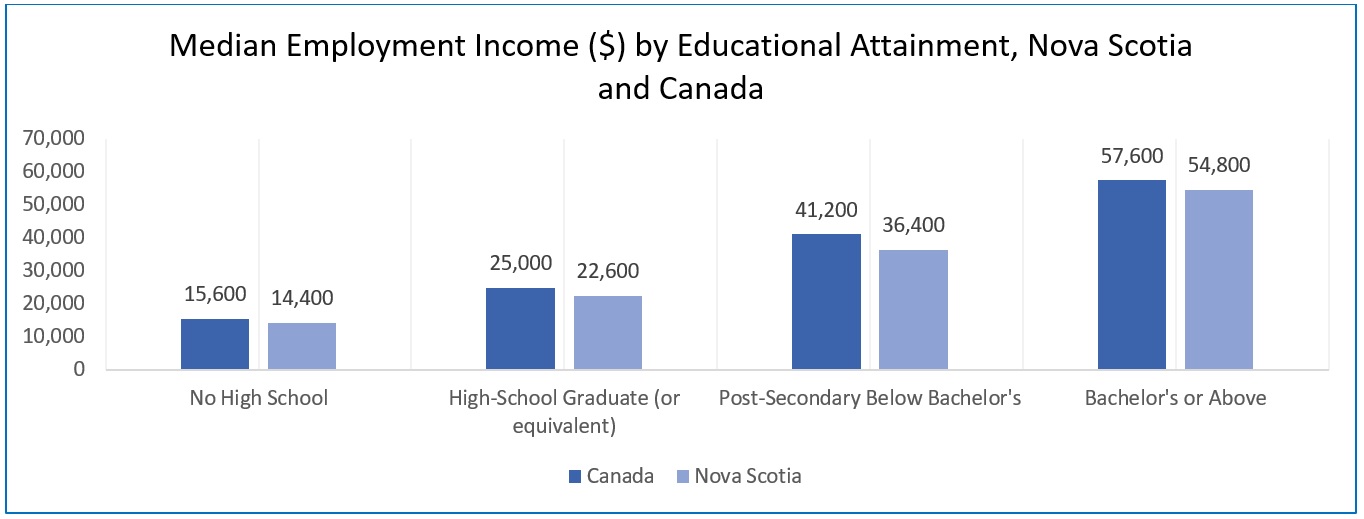Some relevant definitions are:
- Less than high school – this includes people who did not finish high school and those who finished only up to grade 8 or lower.
- High school graduate – received a high school diploma or equivalent.
- Some postsecondary – this includes people who started but didn’t finish a program after high school like a trade, certificate, diploma, or degree.
- Postsecondary certificate or diploma – includes finishing a trade certification, getting a certificate or diploma from a college, or a certificate below a bachelor’s from a university.
- Bachelor’s degree – finished a university bachelor’s degree.
- Above bachelor’s degree – finished a university degree beyond a bachelor.
Education Level
The level of education people have in Nova Scotia is similar to national educational levels
- In 2023, 66% of adults in Nova Scotia had finished some level of education after high school, which is a little less than the national level of 68%. This has not changed from the year before.
- In Nova Scotia, 19% of adults had a bachelor’s degree, which is lower than the national level (22%). For those who had an education beyond a bachelor’s degree, like a master’s or doctorate, it was 10% in Nova Scotia and 11% across Canada.

Calculations based on Statistics Canada Table 14-10-0020-01 (formerly CANSIM 282-0004) Unemployment rate, participation rate and employment rate by educational attainment, annual.
Unemployment Rate
Typically, more education improves the chance of finding work.
Unemployment rates are usually lower at increasing levels of education. This has been true for both national and provincial levels.
In 2023, people with some college education and those with university degrees had higher unemployment than the year before. Everyone else had lower unemployment rates in 2023.
- In Nova Scotia in 2023, people who did not finish high school had the hardest time finding jobs, with a 10% unemployment rate. That is an improvement from the year before when it was 10.6%.
- People who finished high school fared better, with a 6.5% unemployment rate, which is down from 7% in 2022.
- Meanwhile those who started but didn’t finish college had an increase in unemployment from 5.7% in 2022 to 7.2% in 2023.
- People with a college certificate or diploma had an unemployment rate of 5.2%, down from 6.1% the year before.
- People with a university degree had the lowest unemployment rate of only 4.1%, up slightly from 3.6% in 2022.
- Overall, unemployment rates in Nova Scotia are usually higher than the national level, 5.3% compared to 4.5%, but the difference gets smaller with increasing levels of education. For example, people who did not finish high school had an unemployment rate of 10%, which is 1.8 percentage points higher than the national rate of 8.2%. But for those with a university degree, the unemployment rate was 4.2%, just 0.3 percentage points higher than the national average of 3.9%.

Calculations based on Statistics Canada Table 14-10-0020-01 (formerly CANSIM 282-0004) Unemployment rate, participation rate and employment rate by educational attainment, annual.
Income
Higher education levels are linked to higher income levels both provincially and nationally
In Nova Scotia, employment income data shows that those who had higher education levels tended to earn more.
The 2021 numbers below look at incomes based on the level of education people had in 2020.
- If you did not finish high school the median income was $14,400, while people who finished high school or an equivalent earned $8,200 more than those without high school.
- The median income for those with a college certificate, diploma, or a trade earned a median income of $36,400, which is $13,800 higher than those with high school and $22,000 higher than those with less than high school.
- The differences were even greater when compared to people with a bachelor’s degree or more.
- People with a bachelor’s degree or more earned a median income of $54,800, which is $31,200 higher than those with a high school diploma and $40,400 than people who did not finish high school.

Calculations based on Statistics Canada Table 98-10-0411-01 Employment income statistics by highest level of education